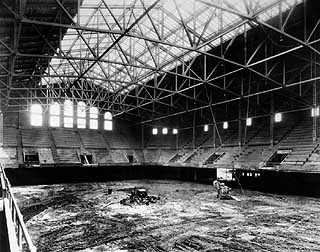|
Subscribe / Renew |
|
|
Contact Us |
|
| ► Subscribe to our Free Weekly Newsletter | |
| home | Welcome, sign in or click here to subscribe. | login |
Construction
| |
 |
November 2, 2000
Rehabbed arena is designed for the future while still respecting the past
LMN Architects
The University of Washington’s Athletic Pavilion opened to great fanfare in 1927. The multipurpose facility was designed to accommodate a wide range of athletic and assembly events that included “state of the art” athletic support facilities. It served a student population less than 25 percent of today’s enrollment, and a student athlete population roughly a sixth the size of that seen today.

Photo courtesy of Special Collections Division, University of Washington Libraries |
The facility has been renovated several times since it opened, with each “modernization” incrementally eroding the Pavilion’s character. The resulting facility was dated in a way that was neither modern nor historical.
This project reestablishes the Bank of America Arena at Hec Edmundson Pavilion as an important element in the composition of the University campus, anchoring the facilities located in the East Campus. The decision to proceed with this project was made following careful analysis comparing the benefits of renovation with those of building a new facility.
The analysis began in 1993 with an objective evaluation and facilities tour. Similar collegiate facilities that had been successfully renovated were compared with major new collegiate facilities. Renovation was chosen on its own merits, rather than from an inability to achieve a new arena.
In fact, it was recognized that the scale and character of the existing facility offered a unique opportunity to improve a competition and practice facility that would be integrated into the East Campus in a way that would not be possible with a much larger, new facility. The guiding philosophy for the restoration would emerge from the following goals:
- Strip away the remains of previous renovations and expose the best features of the original building;
- Produce a spectator-oriented facility, both internally and externally, creating a sense of activity and excitement while modernizing the building and spectator services;
- Modify the seating configuration to develop a more intimate atmosphere for spectators and players, improving ingress and egress, modestly increasing seating capacity and eliminating view obstructions;
- Optimize multi-purpose opportunities;
- Maximize recruiting opportunities by showcasing the history and tradition of Husky athletics; and
- Improve the team support areas.
The current work goes beyond the scope of yet another renovation, resetting its clock to current and future needs while building on the Pavilion’s strengths that were so evident when the original facility opened.
LMN’s design approach builds on the strength of the Pavilion’s original character by stripping away the remains of previous renovations to expose essential character-defining elements. New construction elements are then inserted into the existing framework – exposing and celebrating the juxtaposition. In this manner, the tradition and scale of the original construction is respected in its contrast to the clarity and strength of the new intervention.
The original exterior enclosure of the building has been renovated, preserving the massing and scale of the original building, including its brick façade, steel-sash arched windows and “Husky” gargoyles. On the interior, the original steel roof framing remains, along with the gymnasium spaces along the south edge of the building. The remainder of the interior has been removed and reconfigured.
The ground floor has been completely dedicated to team support areas, housing new locker rooms, meeting rooms, along with equipment and training rooms, for football, men’s and women’s basketball, volleyball and gymnastics. Integrated into this level is a new sports medicine clinic with a connection to the team areas and a new pubic entrance to the north.
The concourse level contains most of the building’s public spaces and utilizes the existing entrances in the northwest and southwest corners of the building. The wide concourses that have always been a distinctive feature of the building, and that were at least partly responsible for the renovation’s feasibility, have been retained. New concession stands and toilet rooms line the concourse. A new practice space has been incorporated in the east-end of the arena.
A complete reconfiguration of the arena interior has created an intimate basketball arena for almost 10,000 spectators.
The existing view-obstructing columns have been removed and replaced with two roof-supporting truss elements, each spanning the length of the facility. Their support columns have been expressed and celebrated at each corner entrance. The existing acoustic ceiling treatment has been removed, exposing the existing roof trusses. Existing windows on the west-end of the arena have once again been exposed, creating a unique spectator connection with the outside environment, protected from the sun by the hill and landscape to the west.
The result is a truly spectator-oriented facility, restoring the lively acoustics, intimate scale and dramatic features of the original while expressing the new elements in clear juxtaposition to their historical context.
Also at concourse level, the project will include the new Husky Store and Husky Hall of Fame, the exhibit area showcasing the history and tradition of Husky Athletics. The Founder’s Club, a multipurpose meeting and entertainment center with adjacent kitchen facilities, along with offices for coaches and staff associated with the facility, are located directly above the Hall of Fame along the west side of the facility.
Chris Eseman, AIA, is partner-in-charge of the Hec Edmundson Pavilion renovation for LMN Architects in Seattle.
Other Stories:
- Robots help with demolition
- Who the heck is Hec?
- UW's Hec Ed is ready for another 75-year run
- Universities spend big to earn more


